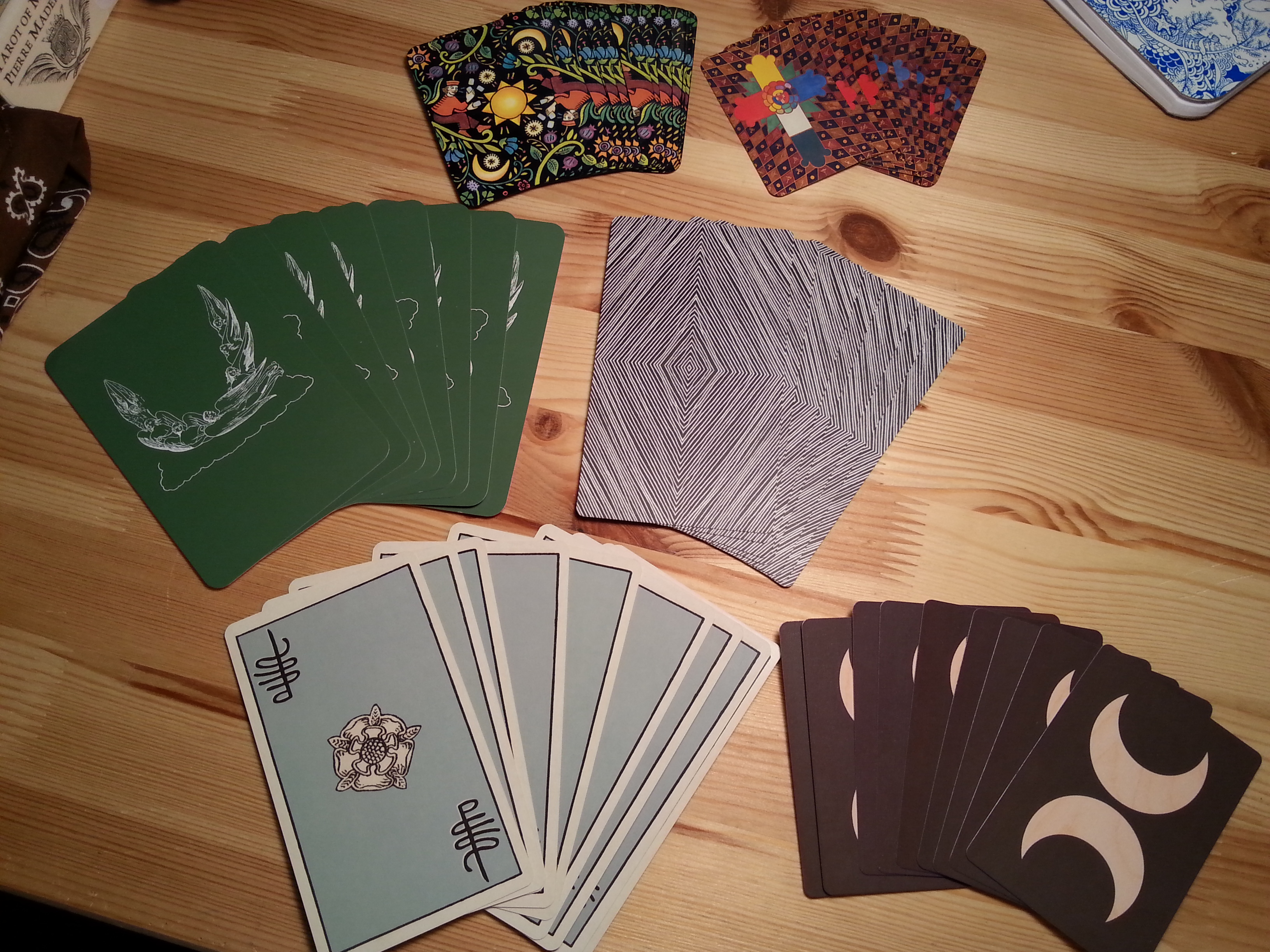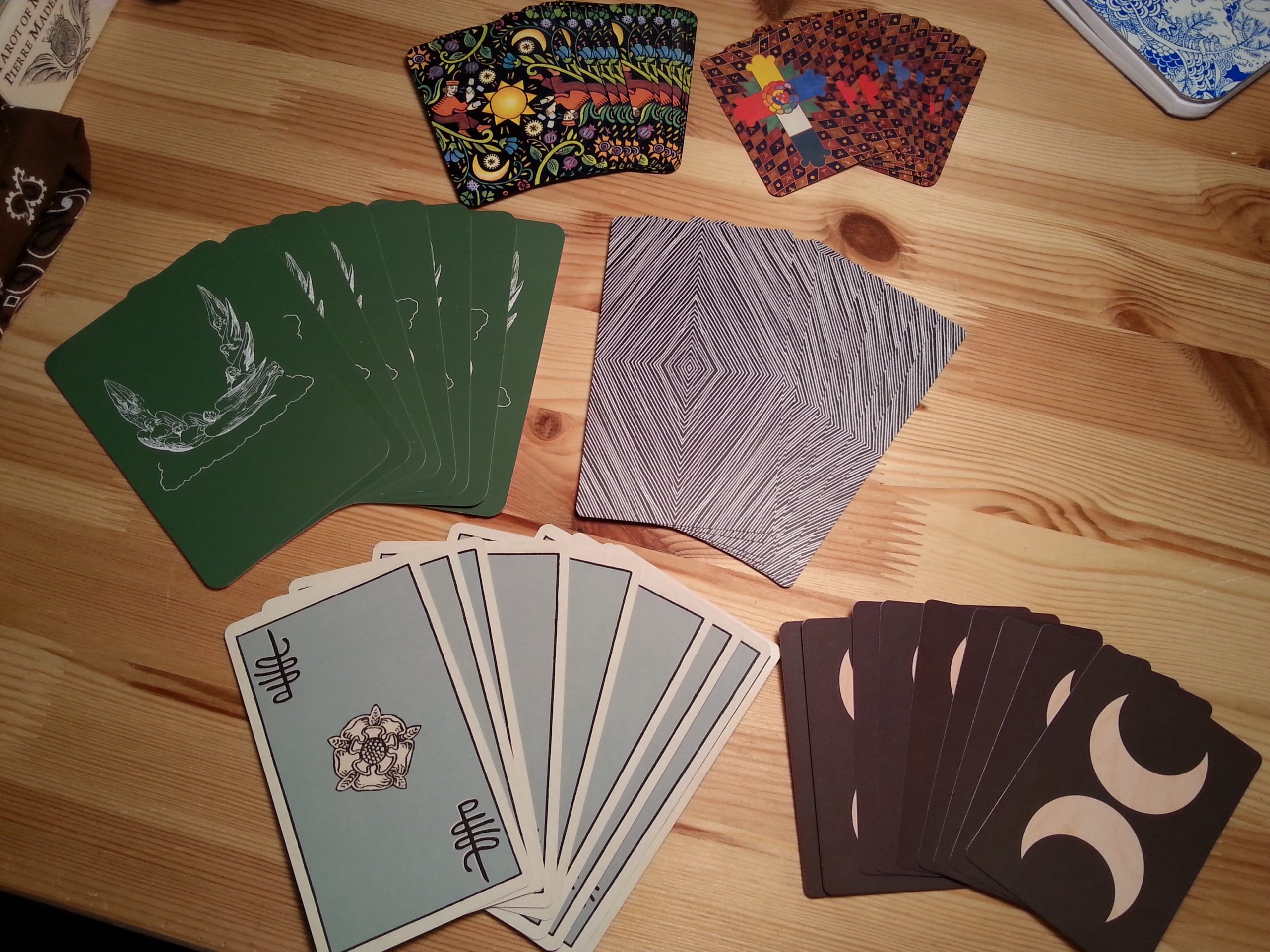If asked the question, Do you read with reversals? I will have to say, “Yes and no.” Mostly, it depends on the deck. I haven’t been asked this question, but it seems like an Obligatory Topic, so I want to talk a little bit about my practice and why I think tarot readers will strengthen their reading skills by reading with and without reversals.
(Reversals, by the way, are when a card appears upside down. They’re pretty hard to ignore.)
I can’t even dignify it with the word “controversy,” but there’s definitely a lot of variance in the tarot community about whether or not one should read with reversed cards. I began reading with reversals before I realized that not doing so was an option, so I came into this conversation with a practice already established, although it has evolved over time. I think I began reading with reversals because I shuffled my first deck of cards riffle-style. Now, it’s possible to riffle and not use reversals–you just have to make sure that both piles are pointing the same direction before you shuffle them together. But to me, it was just a given that some cards would be reversed and some wouldn’t.
One of the biggest factors in how I use a deck is the design on the back of the deck. Deck backs might seem like a minor aesthetic feature when compared to the fronts of the cards, but make a great difference to me because I draw my cards from a fan, rather than off the top of the pile. A sorta-reversible-but-not-really deck back can make the cards frustrating to work with. (I’m lookin’ at you, Dreaming Way Tarot.) When I say that deck backs are “reversible,” I mean they look exactly the same upside down as they do right side up. Some people think that putting a random pattern on the back of a deck makes reversible, but not always. The Dreaming Way, for example, has a pattern that looks consistent, but it’s quite random. If you take one card right side up and another upside down and let the edge of the upside down one peek out from under the right side up one, you will see a difference.
When I go to draw cards after I’ve shuffled, I fan the cards out and choose based on visual cues. I ask the appropriate question for that part of the spread and scan the fanned cards to see which catches my eye. Sometimes my eye goes straight to a card before the question can even be formed in words, sometimes it takes a little longer. I get the best readings from this method; when I cut the deck to draw cards or draw cards off the top of the pile, my readings often make little sense. I need that moment of “choosing” the cards to really connect, but that moment of choosing still needs to be based on intuition rather than intellect.If I know in advance whether or not a card is upside down or right side up before I draw it, it throws me off.

For card backs that aren’t reversible, I just don’t use reversals with that deck and I’m completely fine with that. Thoth and the William Blake Tarot are the two decks I own and love that have completely non-reversible backs. I still use them all the time, especially Thoth. When I can’t use reversals, I just read the cards in other ways, relying more heavily on elemental dignities, visual cues, and spread position to tell when a card is being weakened, challenged, inverted, or begins to shade over into its shadow side.
Deck by Deck
However, it comes down to more than just the card backs. I decide whether or not to use reversals on a deck-by-deck basis after working with a deck for a while. For instance, the Wild Unknown was the second deck I’d ever gotten. I used it all upright for a while because it was a bit of a learning curve for me as a beginning tarot reader. I think I’d also read some stuff online about people not using reversals and thought that maybe I shouldn’t either. One day I was reading with the deck and got a very strong intuitive sense that I was not letting the deck speak with its full voice. By using it only upright, I was limiting it in some way. Since then, I have always used reversals with the Wild Unknown and get very good readings with it.
Conversely, I have never felt comfortable using reversed cards with the Wildwood tarot. Not sure why, but I’ve just never gotten good answers when I’ve tried to use reversals. I find that the deck creators’ intentions have little influence in this area, but it is good to note that the creators of the Wildwood explicitly say that the deck is not designed to work with reversals. However, they do give us that option by making the card backs reversible, which I greatly appreciate. Even so, I keep the cards all upright when I shuffle them.
In my experience, many decks in the Waite-Smith tradition read well with reversals, while I’m not sure that I would read reversals with Thoth even if the card backs were reversible. My next deck purchase will probably be the Mary-el Tarot, which is more of a Thoth based system and I can already tell that I will probably only use it upright, although, again, the backs are reversible. Perhaps it has to to with the more thematic feel of Waite-Smith, versus the archetypal feel of Thoth.
Oracle decks are another topic of discussion here as well. I get the impression that most oracle decks coming out nowadays of the Doreen Virtue / Alana Fairchild / Toni Carmine Salerno variety are not meant to be used with reversals at all. These decks contain mostly positive messages and are meant to be gentle and uplifting in all situations, so working with reversals doesn’t make sense. However, the two oracles I own are the Earthbound Oracle and the Druid Animal Oracle–both quite different from this vein of oracle decks. Both are designed to work with reversals , since the Earthbound Oracle has reversible card backs and the Druid Animal Oracle has both reversible card backs and reversed meanings in the guidebook. However, I’m still on the fence about using reversals with the former and have never felt comfortable using reversals with the latter. I have no good reason, just my gut sense of working with the decks.
Times when I don’t use reversals, even when I can
There are some times when I choose to take a deck that I usually read reversals with and only read the cards upright. For instance, if a spread uses a million cards (like a 36-card year ahead spread) I will only use upright cards, since so much of the deck is being used that a wide range of meanings will be present. Another instance is if I am working with archetypes–say, asking questions about the role of my birth card in my life, or figuring out who I am in the court cards–I’ll only use upright cards. In those cases, I will make it a point to study the upright and shadow meaning of the card anyway.
To switch in a deck from using reversals to all uprights, I will state my intention out loud before the reading: “I am going to use all upright cards in this reading for XYZ reasons.” (I mostly do this for myself, although some might see it as being about communicating with the deck.) I then go through the deck, turn all the cards upright, shuffle, and proceed with the reading. After that reading, I may put the deck back in order to “realign” it.
Practicing with and without reversals
Many people whose opinions I’ve read on this topic pretty much have an all or nothing policy when it comes to reversals. They either read with them all the time, or don’t at all. People who don’t often say that they tried it but it just wasn’t for them. I think there is much to be gained by regularly reading with and without reversals. The two methods build different strengths as a tarot reader.
To me, reversals add a layer of depth to a reading–they give extra information that might be more difficult to access, especially in a reading with only a few cards. Sometimes they can be information overload for sure, which is why I don’t use them with large spreads as I said above. They do, however, add nuance at multiple interpretive levels of the reading–visually, spatially, with elements, and with numbers. (I don’t know enough about astrology or Kabbalah to say if reversals make a difference in these.) I’ve heard people say that the cards are meant to be looked at right side up, so why would you turn them upside down? Well, the Knight of Pentacles in the Waite-Smith deck faces right when he’s right side up–the side of goodness and the conscious. Upside down, he faces left–the direction of shadow and the unconscious. Isn’t that a meaningful change? It’s not that you can’t see the cards properly when they’re upside down–you have to look for the nuances in how they change instead.
But the real reason for reading with reversals is that they do require a lot of the reader. They absolutely require a lot of your intuition to know what the reversal means in that specific context–is it the opposite of the upright card’s meaning? Does it mean that the upright meaning is weakened or delayed? That it’s a negative influence on the situation? Reversals ask a lot of readers, but they repay the effort in increased precision and, of course, increased skill over time.
Finally, one of the best reasons for reading with reversals is the simplest: are there more reversed cards in a spread than upright? Well, that’s a sign we’ve got some very blocked or negative energy around a situation. That information alone can tell us a lot about how to proceed with the reading before we even get to card meanings.
I also think it’s important to learn without reversals. I only truly began to understand the importance of elemental dignities when I started reading without reversals. Not using reversals with certain decks forced me to listen to the quieter aspects of the cards, which can sometimes be a whisper compared to the shout of reversed cards. Without reversals, you have to give more attention to your intuition in figuring out what the dominant ordering principles of a spread are. Do elements matter the most here, or numbers or directionality? Sometimes it’s nice to just sit with the cards and see what comes burbling up.
But ultimately, I think the most important thing is being consistent and deliberate in your practice. If you’ve tried reversals in the past but didn’t like them, you might want to try them with all of your decks before deciding not to read with reversals at all. Have a trial period with each deck to feel what’s best, and once you’ve got a sense of it, be consistent. I deviate from my practice every once in a while, but I do so deliberately and not without good reasons. If you are afraid of reversed cards, then it might be good to work with them and sit with why they make you uncomfortable. Don’t turn all the cards in a deck back upright just because you’re anxious about what will happen if you read with reversed cards. When we are anxious about what answer a tarot deck will give, that’s a sign we need to think about why we’re asking a question.
Those are my thoughts on reversals at the moment. I’m interested to hear your thoughts on this, especially if your practice has changed over time.

Leave a Reply